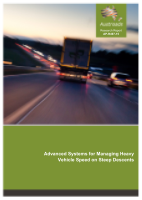Freight

- Publication no: AP-R497-15
- ISBN: 978-1-925294-82-8
- Published: 9 November 2015
- PDF (free) Download
Austroads technical research project ST1863, examined whether a technical solution is available that can identify heavy vehicles, their speed and configuration, and provide appropriate early warning of unsafe operation on descents. The project was not about enforcement, but rather determining if there are technological ‘smart’ advisory solutions to provide early warning to drivers of heavy vehicles.
This report includes a literature review and examination of infrastructure-based, vehicle-based and infrastructure-to-vehicle smart solutions, not systems such as truck escape ramps and safety ramps, which the technological solution is intended to complement rather than replace.
The literature review was able to determine that there are not many infrastructure-based technological systems operating, with limited data on effectiveness. Where the systems have been formally assessed, the assessments indicated a positive effect on driver behaviour.
Although no studies relating to the safety benefits of in-vehicle telematics or DSRC for steep descents were found, the review incorporated searches for general information on the capabilities of telematics devices. Based on general claims about the technical capabilities of in-vehicle telematics, the review was able to identify, on an elementary level, how they may serve as a warning system to heavy vehicle drivers and possibly intervene prior to an incident. Additionally, this study also was able to use a heavy vehicle thermal brake model to examine the effect that road grade, vehicle speed, retarder level and vehicle mass had on brake temperatures on steep downgrades. The study found that the vehicle mass and grade had the largest effect on brake temperatures, while retardation power and vehicle speeds had a lesser, but still significant effect at times.
- Summary
- 1. Introduction
- 2. Infrastructure-based Smart Solutions
- 2.1. Downhill Heavy Vehicle Warning Systems
- 2.1.1. Downhill Truck Warning System, Colorado
- 2.1.2. Downhill Speed Information System, Oregon
- 2.1.3. Downhill Truck Warning System, West Virginia
- 2.1.4. Automated Downgrade Truck Speed Advisory System, British Columbia
- 2.1.5. Downhill Dynamic Warning System, Wyoming
- 2.1.6. Signal Pre-emption System, Pennsylvania
- 2.2. Curve Warning Systems
- 2.2.1. Dynamic Curve Warning Systems, California
- 2.2.2. Heavy Vehicle Speed Awareness System, Victoria
- 2.2.3. Automatic Truck Rollover Warning Systems, Virginia and Maryland
- 2.3. Thermal Imaging of Heavy Vehicle Brakes
- 2.3.1. Renstar Infrared Heavy Vehicle Brake Temperature Measurement System
- 2.3.2. Infrared Inspection System (IRISystem)
- 2.3.3. Brake Temperature Screening System
- 2.3.4. Thermal Imaging Inspection System
- 2.3.5. FLIR i40 Infrared Camera
- 2.4. Points for Consideration
- 2.4.1. System Configuration
- 2.4.2. Location
- 2.4.3. Costs
- 3. Vehicle-based and Co-operative Smart Solutions
- 3.1. In-vehicle Telematics
- 3.2. Advanced Braking Systems
- 3.3. On-board Mass Monitoring
- 3.4. Intelligent Speed Adaptation
- 3.4.1. Speed Alerting Systems
- 3.4.2. Speed Limiting Systems
- 3.4.3. Infrastructure or In-vehicle Requirements
- 3.4.4. Estimated Cost of Implementation
- 3.4.5. Safety Outcomes
- 3.5. Dedicated Short Range Communication
- 3.5.1. Estimated Costs of Implementing DSRC
- 3.6. Geo-fencing
- 3.7. Rebroadcast and Emergency Override Systems
- 3.7.1. Brief Overview of Technology
- 3.7.2. Case Studies
- 3.7.3. Technological Capabilities
- 3.8. Discussion and Considerations
- 3.8.1. Potential
- 3.8.2. Market Penetration
- 3.8.3. Interoperability
- 3.8.4. Input to System
- 3.8.5. Benefits and Costs
- 3.8.6. Way Forward
- 4. Heavy Vehicle Thermal Brake Model
- 5. Conclusions
- References
